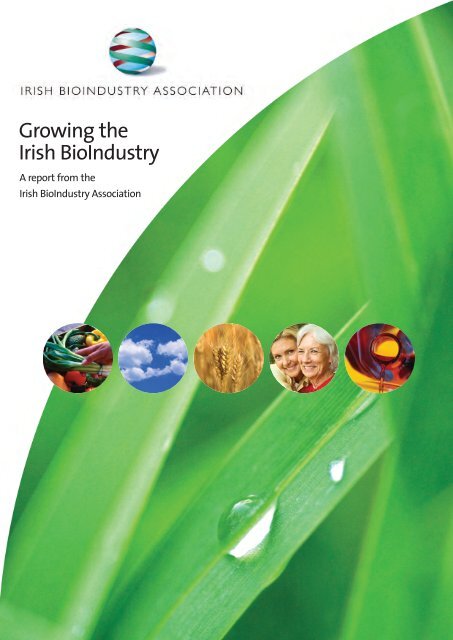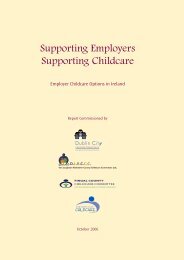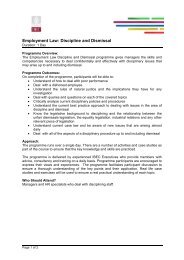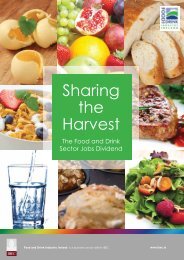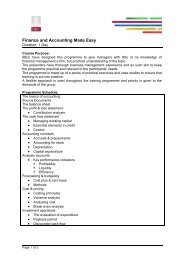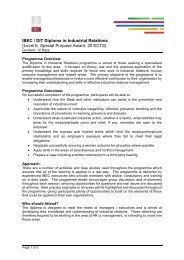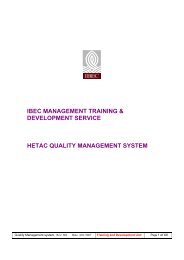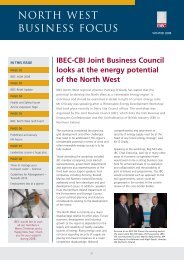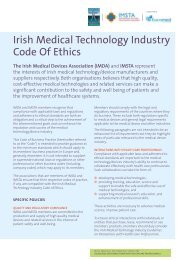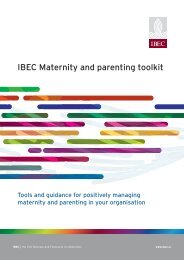Growing the Irish BioIndustry - Irish Business and employers ...
Growing the Irish BioIndustry - Irish Business and employers ...
Growing the Irish BioIndustry - Irish Business and employers ...
You also want an ePaper? Increase the reach of your titles
YUMPU automatically turns print PDFs into web optimized ePapers that Google loves.
<strong>Growing</strong> <strong>the</strong><br />
<strong>Irish</strong> <strong>BioIndustry</strong><br />
A report from <strong>the</strong><br />
<strong>Irish</strong> <strong>BioIndustry</strong> Association
<strong>Growing</strong> <strong>the</strong><br />
<strong>Irish</strong> <strong>BioIndustry</strong><br />
A report from <strong>the</strong><br />
<strong>Irish</strong> <strong>BioIndustry</strong> Association<br />
A promotional brochure produced by <strong>the</strong> <strong>Irish</strong><br />
<strong>BioIndustry</strong> Association, <strong>the</strong> representative body<br />
for <strong>the</strong> biotechnology sector in Irel<strong>and</strong>.<br />
1
Disclaimer<br />
The contents of this brochure are provided as an<br />
information guide only with <strong>the</strong> intention of<br />
enhancing information about <strong>the</strong> <strong>Irish</strong><br />
<strong>BioIndustry</strong> Association <strong>and</strong> <strong>the</strong> <strong>Irish</strong><br />
biotechnology sector in Irel<strong>and</strong>. While every<br />
effort has been made in preparing material for<br />
publication no responsibility is accepted by or on<br />
behalf of <strong>the</strong> <strong>Irish</strong> <strong>BioIndustry</strong> Association for<br />
any errors, omissions or misleading statements<br />
in this brochure.<br />
2
<strong>Growing</strong> <strong>the</strong> <strong>Irish</strong> Biotechnology Industry<br />
Contents<br />
Introduction 4<br />
<strong>Irish</strong> <strong>BioIndustry</strong> Association 4<br />
The Reason for this Brochure 4<br />
Biotechnology Industry Survey:<br />
Trends <strong>and</strong> Forecasts 5<br />
A Knowledge-based Bio-economy 5<br />
Section 1:<br />
The Global Picture 6<br />
Life Sciences <strong>and</strong> Biotechnology –<br />
The Promise 6<br />
The Big Picture: Growth <strong>and</strong> Opportunity 8<br />
Europe, Life Sciences <strong>and</strong> Biotechnology 9<br />
Biopharmaceuticals 9<br />
Primary Production <strong>and</strong> Agri-Food 10<br />
Industrial Production, Energy <strong>and</strong><br />
<strong>the</strong> Environment 10<br />
EU Strategy on Life Sciences <strong>and</strong><br />
Biotechnology Review 10<br />
EU 7th Framework Programme for Research <strong>and</strong><br />
Technological Development (FP7) 11<br />
Breadth <strong>and</strong> Scale of Biotechnology Opportunities 11<br />
Section 2:<br />
Developing A Knowledge-<br />
Based Bio-Economy In Irel<strong>and</strong> 12<br />
Towards a Knowledge-based Economy 12<br />
Infrastructure Supporting <strong>the</strong> Development<br />
of <strong>the</strong> <strong>Irish</strong> Bio-economy 13<br />
Achievement Highlights of <strong>the</strong> <strong>Irish</strong> Bio-economy 14<br />
Economic Strength <strong>and</strong> Stability 16<br />
Decade of Investment Growth <strong>and</strong> Opportunity 17<br />
Research <strong>and</strong> Innovation 18<br />
Biotech in Irel<strong>and</strong> 19<br />
Biopharmaceuticals in Irel<strong>and</strong> 19<br />
HE Sector <strong>and</strong> Industry Research Collaboration 20<br />
Agriculture <strong>and</strong> Food 21<br />
Marine 22<br />
Environment 22<br />
The Story So Far 23<br />
Section 3:<br />
Survey of <strong>the</strong> Biotech<br />
Industry in Irel<strong>and</strong> 24<br />
Survey Terms of Reference <strong>and</strong><br />
Methodology 24<br />
Summary of Key Findings <strong>and</strong> Trends 25<br />
3<br />
Appendices 30<br />
Appendix 1: OECD List-based Definition of<br />
Biotechnology Techniques 30<br />
Appendix 2: IBIA List of Members 31
<strong>Irish</strong> <strong>BioIndustry</strong><br />
Association<br />
The <strong>Irish</strong> <strong>BioIndustry</strong> Association (IBIA) was formally<br />
launched ten years ago by <strong>the</strong> <strong>Irish</strong> <strong>Business</strong> <strong>and</strong><br />
Employers Confederation (IBEC 1 ), in response to <strong>the</strong><br />
needs of <strong>the</strong> rapidly emerging modern biotechnology<br />
industry.<br />
Today, <strong>the</strong> IBIA is <strong>the</strong> representative body for <strong>the</strong><br />
Biotechnology industry in Irel<strong>and</strong>. Its membership<br />
encompasses all sectors of <strong>the</strong> biotechnology<br />
industry including manufacturing, distribution <strong>and</strong><br />
biotech industry support services.<br />
The IBIA plays a key role in ensuring that <strong>the</strong> voice of<br />
<strong>the</strong> industry is clearly articulated <strong>and</strong> influential when<br />
it comes to <strong>the</strong> development of national policy, thus<br />
setting a strategic course for <strong>the</strong> development of <strong>the</strong><br />
sector. Most importantly, it provides an effective<br />
forum vital for creating <strong>and</strong> sustaining strong<br />
relationships with government <strong>and</strong> <strong>the</strong> key interest<br />
groups within <strong>the</strong> Health <strong>and</strong> Life Sciences sector in<br />
Irel<strong>and</strong>, <strong>and</strong> abroad. The IBIA also stimulates lively<br />
debate <strong>and</strong> discussion on <strong>the</strong> challenges facing <strong>the</strong><br />
biotechnology industry today.<br />
The main aim of <strong>the</strong> IBIA is to promote, support <strong>and</strong><br />
encourage <strong>the</strong> continuous development of <strong>the</strong> multinational<br />
<strong>and</strong> indigenous biotech sector in Irel<strong>and</strong>.<br />
IBIA is a fulltime member of BIO (US 2 ) <strong>and</strong><br />
EUROPABIO 3 .<br />
The biotechnology industry has found a natural<br />
home in Irel<strong>and</strong>, which has demonstrated its<br />
commitment to <strong>the</strong> development of <strong>the</strong> industry in<br />
<strong>the</strong> clearest possible ways. Irel<strong>and</strong> has created a<br />
highly structured supportive environment that<br />
provides <strong>the</strong> right conditions <strong>and</strong> <strong>the</strong> substantial<br />
resources necessary for encouraging strategic<br />
investment in innovation, research <strong>and</strong> development,<br />
business growth <strong>and</strong> commercial success, in this<br />
sector.<br />
The Reason for this Brochure<br />
This brochure was prompted initially by <strong>the</strong> many<br />
overseas requests received by <strong>the</strong> <strong>Irish</strong> <strong>BioIndustry</strong><br />
Association for an overview of <strong>the</strong> <strong>Irish</strong><br />
Biotechnology sector <strong>and</strong> <strong>the</strong> scope of activity<br />
supporting this rapidly developing industry in Irel<strong>and</strong>.<br />
4<br />
1 IBEC represents 7,500 member businesses <strong>and</strong> organisations from<br />
all sectors, providing a comprehensive range of services to its<br />
members <strong>and</strong> is <strong>the</strong> national voice of <strong>Irish</strong> business <strong>and</strong> <strong>employers</strong><br />
2 BIO (US) is <strong>the</strong> representative organisation for biotechnology<br />
companies in <strong>the</strong> United States<br />
3 EuropaBio is <strong>the</strong> representative organisation for <strong>the</strong> biotechnology<br />
industry in Europe
<strong>Growing</strong> <strong>the</strong> <strong>Irish</strong> Biotechnology Industry<br />
Biotechnology Industry<br />
Survey: Trends <strong>and</strong><br />
Forecasts<br />
A Knowledge-based<br />
Bio-economy<br />
As part of <strong>the</strong> development of <strong>the</strong> information<br />
brochure, <strong>the</strong> IBIA felt it would be timely to conduct<br />
a survey of <strong>the</strong> biotechnology industry 4<br />
in Irel<strong>and</strong><br />
with <strong>the</strong> object of establishing at first h<strong>and</strong> an up-todate<br />
position on <strong>the</strong>ir business operations, current<br />
trends <strong>and</strong> future forecasts. The main findings of <strong>the</strong><br />
survey are included (pages 24-29).<br />
In considering <strong>the</strong> scope of activity supporting <strong>the</strong><br />
development of <strong>the</strong> biotechnology industry in Irel<strong>and</strong><br />
a picture emerges of a country that is deeply<br />
committed to becoming one of <strong>the</strong> world’s leading<br />
biotech hubs <strong>and</strong> is already well on <strong>the</strong> way to<br />
becoming recognised as a leading knowledge-based<br />
bio-economy.<br />
The presence in Irel<strong>and</strong> of a well established global<br />
pharmaceutical industry with annual exports of<br />
€42 billion, combined with recent substantial multinational<br />
biotech investments places <strong>the</strong> country in a<br />
prime position for <strong>the</strong> growth <strong>and</strong> development of<br />
<strong>the</strong> sector.<br />
Unprecedented state investment in <strong>the</strong> development<br />
of infrastructure <strong>and</strong> <strong>the</strong> creation of a world-class<br />
research environment fur<strong>the</strong>r advances Irel<strong>and</strong><br />
towards its goal of becoming a world leader in<br />
innovation.<br />
4 Terms of reference for selection of<br />
companies surveyed was determined by<br />
<strong>the</strong> OECD definition of Biotechnology:<br />
“The application of science <strong>and</strong><br />
technology to living organisms, as well<br />
as parts, products or models <strong>the</strong>reof, to<br />
alter living or non-living materials for <strong>the</strong><br />
production of knowledge, goods or<br />
materials.”<br />
5
Section One THE GLOBAL PICTURE<br />
6<br />
“<br />
Life Sciences <strong>and</strong><br />
Biotechnology –<br />
The Promise<br />
There are currently over 6.4 billion<br />
people living on <strong>the</strong> planet, a<br />
figure which is increasing by 77<br />
million each year. By 2050, <strong>the</strong><br />
United Nations estimates that<br />
total world population will be<br />
over 9.3 billion. The bulk of this<br />
population growth will occur in<br />
<strong>the</strong> developing world, where<br />
today over 1.2 billion people,<br />
mainly women <strong>and</strong> children, are<br />
living in extreme poverty. Coping<br />
with this future population<br />
increase will pose severe social<br />
<strong>and</strong> environment challenges for<br />
global leaders, not least of which<br />
will be providing enough food to<br />
go round.<br />
Life sciences <strong>and</strong> biotechnology<br />
are likely to be important tools in<br />
<strong>the</strong> fight to feed <strong>the</strong> world’s<br />
growing population. New<br />
biotechnology techniques have<br />
<strong>the</strong> potential to deliver improved<br />
food quality <strong>and</strong> environmental<br />
benefits through agronomically<br />
enhanced crops. Enhanced food<br />
<strong>and</strong> feed quality may be linked to<br />
disease prevention, <strong>and</strong> may<br />
result in <strong>the</strong> reduced use of<br />
chemical pesticides, fertilisers<br />
<strong>and</strong> drugs, leading to more<br />
sustainable agricultural practices<br />
in both <strong>the</strong> developed <strong>and</strong><br />
developing world. Advances in<br />
biotechnology can also result in<br />
major healthcare benefits,<br />
allowing for <strong>the</strong> production of<br />
cheaper, safer drugs in large<br />
quantities. Personalised <strong>and</strong><br />
preventative medicines based on<br />
genetic predisposition, targeted<br />
screening, <strong>and</strong> innovative drug<br />
treatments are among <strong>the</strong><br />
possibilities on offer.
<strong>Growing</strong> <strong>the</strong> <strong>Irish</strong> Biotechnology Industry<br />
Despite <strong>the</strong>se clear advantages,<br />
<strong>the</strong> subject of biotechnology, <strong>and</strong><br />
genetically modified organisms<br />
(GMOs) in particular, has raised<br />
widespread public concern about<br />
<strong>the</strong> possible impact on human<br />
health <strong>and</strong> <strong>the</strong> environment. The<br />
sensitivity of this issue highlights<br />
<strong>the</strong> need for responsible policies<br />
at EU <strong>and</strong> international level to<br />
ensure <strong>the</strong>se concerns are<br />
addressed <strong>and</strong> that <strong>the</strong> protection<br />
of <strong>the</strong> environment <strong>and</strong> human<br />
health remains a priority at all<br />
times. The EU has been<br />
legislating on GMOs since<br />
<strong>the</strong> early 1990s.<br />
These rules <strong>and</strong> regulations cover<br />
<strong>the</strong> use, traceability <strong>and</strong> labelling<br />
of GMOs or products <strong>and</strong> feeds<br />
containing GMOs <strong>and</strong> are<br />
designed to protect <strong>the</strong> health<br />
of both citizens <strong>and</strong> <strong>the</strong><br />
environment.<br />
Stavros Dimos,<br />
“<br />
EU Commissioner for <strong>the</strong> Environment<br />
7
The <strong>Irish</strong> <strong>BioIndustry</strong> Association<br />
The Big Picture:<br />
Growth <strong>and</strong> Opportunity<br />
The global picture today of <strong>the</strong> biotechnology<br />
industry is <strong>the</strong> opening chapter of an exciting story<br />
of innovation, research <strong>and</strong> development, global<br />
competitiveness, strategic investment, market<br />
positioning <strong>and</strong> <strong>the</strong> evolution of <strong>the</strong> knowledge<br />
economy.<br />
The report on <strong>the</strong> global biotechnology industry by<br />
Ernst & Young “Beyond Borders: Global Technology<br />
Report 2007” 5<br />
reveals a dynamic global industry<br />
sector experiencing robust growth <strong>and</strong> reports that<br />
capital raised by <strong>the</strong> world’s biotechnology<br />
companies grew by 42% in 2006 to US$27.9 billion<br />
<strong>and</strong> venture capital reached an all time high of<br />
US$5.4 billion.<br />
The report recognised Irel<strong>and</strong> among <strong>the</strong> top 25<br />
global locations for biotechnology.<br />
In Europe <strong>the</strong> report finds that revenue growth in <strong>the</strong><br />
biotech sector of 13% in 2006 was more than twice<br />
<strong>the</strong> growth experienced in 2005 contributing €13.3<br />
billion revenues for public <strong>and</strong> private biotech<br />
companies.<br />
While <strong>the</strong>se figures are impressive, of particular<br />
significance is that <strong>the</strong> pipelines of EU publicly traded<br />
companies grew 30% bringing <strong>the</strong> overall pipeline to<br />
nearly 700 compounds with 27 in registration<br />
awaiting regulatory approval.<br />
In addition to this healthy picture it is reported that<br />
Europe’s privately held biotechnology companies<br />
have some 800 compounds in <strong>the</strong>ir pipelines <strong>and</strong> 12<br />
compounds in registration.<br />
That said, it is also recognised that <strong>the</strong> development<br />
of new biotechnology applications is time<br />
consuming, expensive <strong>and</strong> requires access to<br />
significant resources, including specialist expertise<br />
<strong>and</strong> experience <strong>and</strong> infrastructure <strong>and</strong> finance.<br />
The development of <strong>the</strong> biotechnology industry is<br />
increasingly dependent on a collaborative effort<br />
between Industry, Higher Education <strong>and</strong> Research<br />
Institutes, National Governments, State Agencies <strong>and</strong><br />
Venture Capital Companies.<br />
Financing increased by a dramatic 45% reaching<br />
€4.7 billion <strong>and</strong> Venture Capital financings of<br />
biotech reached its highest ever peak of €1.5 billion<br />
in 2006.<br />
5 Ernst & Young,“Beyond Borders: Global Technology Report 2007”<br />
8
<strong>Growing</strong> <strong>the</strong> <strong>Irish</strong> Biotechnology Industry<br />
Europe, Life Sciences<br />
<strong>and</strong> Biotechnology<br />
Biopharmaceuticals<br />
The European dedicated biotechnology industry<br />
directly employs nearly 97,000 people, mostly in<br />
SMEs, with 44% of employees involved in R&D<br />
activities. In 2004, biotechnology companies spent<br />
€7.6 billion on R&D 6 .<br />
Employment in industries that use biotechnology is<br />
many times higher. In 2004 <strong>the</strong> European pharmaceutical<br />
industry employed over 100,000 people in<br />
research <strong>and</strong> development alone <strong>and</strong> invested over<br />
€21 billion 7 .<br />
Following a request by <strong>the</strong> European Parliament <strong>the</strong><br />
Biotechnology for Europe study (Bio4EU) 8<br />
was<br />
initiated by <strong>the</strong> European Commission <strong>and</strong> published<br />
in 2007.<br />
The study was a major undertaking <strong>and</strong> is likely in<br />
<strong>the</strong> future to become a benchmark of <strong>the</strong> early days<br />
of <strong>the</strong> application of this science. It supports <strong>the</strong> view<br />
that <strong>the</strong> future holds great potential for biotechnology<br />
based industry in Europe.<br />
The main biotech product groups are biopharmaceuticals<br />
with a share of 9% of turnover from all<br />
pharmaceuticals in <strong>the</strong> EU in 2005. Recombinant<br />
vaccines targeted at Hepatitis B had a share of 17%<br />
of turnover from all vaccines in <strong>the</strong> EU in 2005 <strong>and</strong><br />
modern biotechnology based in vitro (IVD)<br />
diagnostics had a share of approximately 30% of<br />
turnover for all (IVD) in <strong>the</strong> EU in <strong>the</strong> same period.<br />
The report emphasises <strong>the</strong> point that modern<br />
biotechnology provides powerful tools not only for<br />
research <strong>and</strong> development work on biopharmaceuticals,<br />
but also on small molecule drugs, vaccines<br />
<strong>and</strong> diagnostics.<br />
The potential for growth in <strong>the</strong> biopharmaceutical<br />
sector appears to be very substantial.<br />
Overall <strong>the</strong> study found that modern biotechnology<br />
<strong>and</strong> processes are an integral part of <strong>the</strong> EU<br />
economy particularly in manufacturing, including<br />
pharmaceuticals, agri-food <strong>and</strong> healthcare <strong>and</strong><br />
estimates that modern biotechnology accounts for<br />
up to 1.69% of <strong>the</strong> EU economy, comparable to<br />
o<strong>the</strong>r sectors such as agriculture (1.79%) or<br />
chemicals (1.95%) 9 .<br />
6 EUROPA: MEMO/07/130 Date: 11/04/2007<br />
7 IPHA: Healthcare Facts <strong>and</strong> Figures 2006, Research <strong>and</strong> Development<br />
8 Bio4EU, www.jrc.es<br />
9 Consequences, Opportunities <strong>and</strong> Challenges of Modern<br />
Biotechnology http://bio4eu.jrc.es/index.html<br />
9
The <strong>Irish</strong> <strong>BioIndustry</strong> Association<br />
Primary Production<br />
<strong>and</strong> Agri-Food<br />
EU Strategy on Life<br />
Sciences <strong>and</strong><br />
Biotechnology Review<br />
Bio4EU also found that modern biotechnology<br />
affects large parts of primary production <strong>and</strong> <strong>the</strong><br />
agri-food sector with respect to <strong>the</strong> breeding <strong>and</strong><br />
propagation of crops; veterinary <strong>and</strong> food<br />
diagnostics, vaccines <strong>and</strong> enzymes for food<br />
production.<br />
Use of biotechnology-derived products by <strong>the</strong> EU<br />
agri-food sector contributes between 32% <strong>and</strong> 38%<br />
of its turnover.<br />
In a mid-term review of <strong>the</strong> EU’s Strategy on Life<br />
Sciences <strong>and</strong> Biotechnology 2002 -2010 10<br />
a new set<br />
of five interdependent biotech actions that require<br />
<strong>the</strong> collaboration of <strong>the</strong> European Commission,<br />
Member States, International Organisations,<br />
Universities, Research Organisations, Industry <strong>and</strong><br />
Civil Society Organisations were proposed. These<br />
actions are geared towards ensuring that Europe<br />
maintains a competitive <strong>and</strong> sustainable knowledgebased<br />
bio-economy.<br />
Industrial Production,<br />
Energy <strong>and</strong> <strong>the</strong><br />
Environment<br />
In Irel<strong>and</strong>, <strong>the</strong>se linkages have been a strategic<br />
priority for <strong>the</strong> last decade.<br />
Proposed Actions<br />
The Bio4EU study found that generally where<br />
industrial biotechnology is applied it has positive<br />
economic <strong>and</strong> environmental implications e.g.<br />
industrial biotechnology reduces energy <strong>and</strong> water<br />
consumption <strong>and</strong> emissions including <strong>the</strong><br />
greenhouse gas CO 2 .<br />
Promote research <strong>and</strong> development for biobased<br />
products <strong>and</strong> improve <strong>the</strong> uptake of<br />
new technologies<br />
Foster competitiveness, knowledge transfer<br />
<strong>and</strong> innovation from <strong>the</strong> science base to<br />
industry<br />
Encourage debate on <strong>the</strong> benefits <strong>and</strong> risks<br />
of life sciences <strong>and</strong> biotechnology<br />
10<br />
10 Communication from <strong>the</strong> European Commission to <strong>the</strong> Council, <strong>the</strong><br />
European Parliament, The European Economic <strong>and</strong> Social <strong>and</strong> <strong>the</strong><br />
Committee of <strong>the</strong> regions on <strong>the</strong> mid term review of <strong>the</strong> Strategy<br />
on Life Sciences <strong>and</strong> Biotechnology ref: IP/07/484<br />
Ensure a sustainable contribution of modern<br />
biotechnology to agriculture<br />
Improve <strong>the</strong> implementation of legislation<br />
<strong>and</strong> its impact on competitiveness.
<strong>Growing</strong> <strong>the</strong> <strong>Irish</strong> Biotechnology Industry<br />
EU 7th Framework<br />
Programme for Research<br />
<strong>and</strong> Technological<br />
Development (FP7)<br />
Breadth <strong>and</strong> Scale of<br />
Biotechnology<br />
Opportunities<br />
Under <strong>the</strong> EU 7th Research Framework Programme 11 ,<br />
a budget for <strong>the</strong> next seven years of €50.5 billion<br />
has been allocated, of which €8 billion is specifically<br />
dedicated to Life Sciences <strong>and</strong> Biotechnologies. Of<br />
this, 75% will support health research a key area in<br />
which Irel<strong>and</strong> is well positioned to respond.<br />
FP7 is essentially <strong>the</strong> strategic funding mechanism to<br />
progress <strong>the</strong> Lisbon Agenda 12<br />
aimed at improving<br />
European competitiveness <strong>and</strong> knowledge base.<br />
The FP7 budget represents an increase of 41% on<br />
<strong>the</strong> FP6 budget <strong>and</strong> demonstrates <strong>the</strong> imperative for<br />
Europe to invest in life sciences <strong>and</strong> biotechnology<br />
<strong>and</strong> to build on <strong>the</strong> contribution made by past<br />
programmes, which included funding some 1,000<br />
full-time PhDs <strong>and</strong> attracting world-class researches<br />
to Europe.<br />
It is not easy to identify an area of modern scientific<br />
research <strong>and</strong> discovery that does not or may not in<br />
<strong>the</strong> future include some aspect of biotechnology. It<br />
has been suggested by some experts for instance<br />
that by 2020 as much as 50% of all pharmaceutical<br />
products will incorporate some aspect of<br />
biotechnology.<br />
In <strong>the</strong> field of science, genomics <strong>and</strong> biotechnology<br />
for health, €2.5 billion was invested in more than<br />
600 projects in 2006, looking at issues such as:<br />
■<br />
■<br />
■<br />
■<br />
Cancer<br />
Cardio-Vascular Diseases<br />
Diabetes<br />
Fundamental Genomics<br />
On <strong>the</strong> food side 186 projects were funded in <strong>the</strong><br />
field of plant biotechnology, food safety <strong>and</strong><br />
nutrition, to name but a few.<br />
Under <strong>the</strong> EU 6th Framework Programme for<br />
Research <strong>and</strong> Development, <strong>Irish</strong> researchers were<br />
successful in securing approximately €200 million 13 .<br />
All <strong>the</strong> indications are that life sciences <strong>and</strong><br />
biotechnology applications are set to transform <strong>the</strong><br />
pharmaceutical, health, diagnostics, agricultural,<br />
environmental <strong>and</strong> industrial l<strong>and</strong>scape of Europe<br />
<strong>and</strong> <strong>the</strong> world.<br />
11 The Seventh Framework Programme for research <strong>and</strong> technological<br />
development (FP7) is <strong>the</strong> European Unions main instrument for<br />
funding research in Europe. FP7 applies to <strong>the</strong> years 2007-2013.<br />
See: cordis.europa.eu/fp7/<br />
12 The Lisbon Agenda is an EU action <strong>and</strong> development plan to make<br />
<strong>the</strong> EU <strong>the</strong> most competitive knowledge-based economy in <strong>the</strong><br />
world<br />
13 Department of Enterprise Trade <strong>and</strong> Employment, European <strong>and</strong><br />
International Programmes 28/06/2007<br />
11
Section Two DEVELOPING A KNOWLEDGE-BASED<br />
BIO-ECONOMY IN IRELAND<br />
Towards a Knowledgebased<br />
Economy<br />
As an enabling technology with potentially<br />
multiple applications, biotechnology will play an<br />
increasingly significant role in <strong>the</strong> development<br />
of Irel<strong>and</strong>’s key industries:<br />
■<br />
■<br />
■<br />
Pharmaceutical <strong>and</strong> Healthcare<br />
Agriculture, Food <strong>and</strong> Marine<br />
Medical Devices <strong>and</strong> Diagnostics<br />
The vision <strong>and</strong> objective of <strong>the</strong> <strong>Irish</strong> Strategy for<br />
Science, Technology <strong>and</strong> Innovation 14<br />
is: to<br />
achieve international renown for <strong>the</strong> excellence<br />
of its research, <strong>and</strong>, to be at <strong>the</strong> forefront in<br />
generating <strong>and</strong> using new knowledge for<br />
economic <strong>and</strong> social progress within an<br />
innovation driven culture.<br />
The Health <strong>and</strong> Life Sciences sector is integral to<br />
realising this objective <strong>and</strong> is central to Irel<strong>and</strong>’s<br />
National Development Plan (2007-2013), <strong>the</strong> key<br />
strategy for sustaining Irel<strong>and</strong>’s economic<br />
growth <strong>and</strong> contributing to <strong>the</strong> overarching<br />
objective of <strong>the</strong> renewed Lisbon Agenda to<br />
make Europe <strong>the</strong> most competitive <strong>and</strong> <strong>the</strong> most<br />
dynamic knowledge-based economy in <strong>the</strong><br />
world.<br />
The pharmaceutical industry in Irel<strong>and</strong> is a<br />
central column of <strong>the</strong> <strong>Irish</strong> economy accounting<br />
for 45% of all manufacturing exports <strong>and</strong> <strong>Irish</strong><br />
owned Agri-Food firms now account for 57% of<br />
exports from indigenous industries.<br />
Both of <strong>the</strong>se sectors are at <strong>the</strong> very heart of<br />
innovative biotechnology research <strong>and</strong><br />
development worldwide.<br />
Over <strong>the</strong> lifetime of Irel<strong>and</strong>’s National<br />
Development Plan (2007-2013) <strong>the</strong> state will<br />
invest €8.2 billion in scientific research 15 .<br />
12<br />
Science Foundation Irel<strong>and</strong> (SFI), <strong>the</strong><br />
organisation responsible for providing awards<br />
to support scientists <strong>and</strong> engineers working in<br />
biotechnology <strong>and</strong> information <strong>and</strong> communications<br />
technology will invest €1.4 billion in <strong>the</strong>se<br />
sectors over <strong>the</strong> life of <strong>the</strong> National<br />
Development Plan (2007-2013).
<strong>Growing</strong> <strong>the</strong> <strong>Irish</strong> Biotechnology Industry<br />
Infrastructure Supporting<br />
<strong>the</strong> Development of <strong>the</strong><br />
<strong>Irish</strong> Bio-economy<br />
The process of building <strong>the</strong> support structures<br />
needed for a knowledge-based <strong>Irish</strong> bio-economy<br />
was accelerated a decade ago through a series of<br />
initiatives in response to <strong>the</strong> recommendations of <strong>the</strong><br />
government commissioned Technology Foresight<br />
Report 16 . The report recommended strongly, that:<br />
“The Government must immediately invest, on a<br />
realistic scale, in a co-ordinated biotechnology<br />
programme, which builds strong links between<br />
universities, industry, agriculture <strong>and</strong> <strong>the</strong> financial<br />
services sectors”.<br />
For a decade now, following <strong>the</strong> acceptance of <strong>the</strong><br />
report’s recommendations, substantial <strong>and</strong><br />
unprecedented investment has been made by <strong>the</strong><br />
<strong>Irish</strong> Government to help create a world-class R&D<br />
infrastructure with strong linkages between industry,<br />
higher education, state agencies, research<br />
institutes <strong>and</strong> government with <strong>the</strong><br />
objective of establishing a thriving<br />
knowledge-based bio-economy<br />
in Irel<strong>and</strong>.<br />
14 Department of Enterprise Trade <strong>and</strong> Employment: Strategy for<br />
Science Technology <strong>and</strong> Innovation 2006 - 2013<br />
15 Source: Science Foundation Irel<strong>and</strong> (SFI)<br />
16 See Technology Foresight Reports of <strong>the</strong> <strong>Irish</strong> Council for Science,<br />
Technology <strong>and</strong> Innovation 1999 on ICTSI website<br />
13
The <strong>Irish</strong> <strong>BioIndustry</strong> Association<br />
Achievement Highlights<br />
of <strong>the</strong> <strong>Irish</strong> Bio-economy<br />
Building <strong>the</strong> <strong>Irish</strong> Bio-economy<br />
Putting in place <strong>the</strong> infrastructure to support this development has been a national priority over <strong>the</strong> last decade.<br />
Significant progress has been achieved consequently, <strong>and</strong> includes:<br />
■<br />
The establishment of Science Foundation Irel<strong>and</strong> (SFI) with responsibility to invest €1.4 billion of <strong>the</strong><br />
€8.2 billion that has been allocated for scientific research as part of <strong>the</strong> National Development Plan<br />
(2007-2013) <strong>and</strong> <strong>the</strong> Strategy for Science Technology <strong>and</strong> Innovation (2006 - 2013).<br />
■<br />
The SFI Bioscience <strong>and</strong> Bioengineering Directorate currently funds 130 research principle investigators<br />
(PIs) <strong>and</strong> has invested €260 million in research projects in research areas encompassing agri-food,<br />
neuroscience, immunology, molecular <strong>and</strong> cell biology, microbiology, nanotechnology, sensors/devices<br />
<strong>and</strong> bioinformatics/systems biology. SFI also facilitate maximum participation in EU <strong>and</strong> o<strong>the</strong>r<br />
programmes.<br />
■<br />
SFI has invested over €100 million establishing seven Research Centres for Science, Engineering <strong>and</strong><br />
Technology (CSETs), including:<br />
■<br />
The Biomedical Diagnostics Institute (BDI), Dublin City University, specialising in <strong>the</strong> development of<br />
next generation biomedical diagnostic services measuring indicators of chronic diseases for use in<br />
medical settings <strong>and</strong> at home.<br />
■<br />
Alimentary Pharmabiotic Centre, (UCC) University College Cork is focused on <strong>the</strong> discovery,<br />
development <strong>and</strong> commercialisation of proprietary products for <strong>the</strong> treatment of gastro-intestinal<br />
disorders <strong>and</strong> o<strong>the</strong>r inflammatory conditions with a particular focus on <strong>the</strong> development of probiotic<br />
technologies <strong>and</strong> products.<br />
■<br />
The Centre for Research on Adaptive Nanostructures <strong>and</strong> Nanodevices (CRANN), Trinity College<br />
Dublin, is an internationally recognised centre of excellence in nanoscience where <strong>the</strong>re is a<br />
convergence of <strong>the</strong> disciplines of biology, chemistry <strong>and</strong> physics.<br />
14<br />
■<br />
The Regenerative Medicine Institute (REMEDI), National University of Irel<strong>and</strong>, Galway is developing<br />
gene <strong>the</strong>rapy to promote tissue repair <strong>and</strong> is currently working in cooperation with Medtronic Inc, a<br />
world leader in medical devices currently focussing on cardiovascular disease.
<strong>Growing</strong> <strong>the</strong> <strong>Irish</strong> Biotechnology Industry<br />
■<br />
The Industrial Development Authority (IDA) has been particularly successful in attracting substantial<br />
investments into Irel<strong>and</strong> from global biopharmaceutical companies including Wyeth, Schering Plough,<br />
Genzyme, Elan, Merck Sharp & Dohme, Allergan, Pfizer, Gilead, <strong>and</strong> GeneMedix. There are more<br />
than 1,000 IDA supported foreign companies in Irel<strong>and</strong>.<br />
■<br />
NIBRT (National Institute for Bio-processing Research <strong>and</strong> Training) is a world-class institute<br />
supporting <strong>the</strong> development of <strong>the</strong> bioprocessing industry in Irel<strong>and</strong>. The institute is based on<br />
collaboration between University College Dublin, Trinity College Dublin, Dublin City University <strong>and</strong><br />
<strong>the</strong> Institute of Technology Sligo, providing training <strong>and</strong> specialist research for <strong>the</strong> bioprocessing<br />
industry. NIBERT is funded by <strong>the</strong> IDA.<br />
■<br />
FAS bioprocessing training centre Cork is a new Bio Pharma Process Training Facility with government<br />
investment of €3.5 million. The new facility, which will provide “h<strong>and</strong>s-on” practical training, is<br />
established in Carrigaline, Co. Cork. The establishment of this new facility is ano<strong>the</strong>r important step<br />
in improving Irel<strong>and</strong>’s capability to continue to provide <strong>the</strong> training <strong>and</strong> supply of quality skilled<br />
operatives <strong>and</strong> craftspersons to <strong>the</strong>se sectors.”<br />
■<br />
Enterprise Irel<strong>and</strong> (EI) is <strong>the</strong> <strong>Irish</strong> development agency whose focus is on accelerating <strong>the</strong><br />
development of <strong>Irish</strong> companies. The 2008-2010 strategy has set a robust target of 225 companies<br />
to achieve annual global sales by 2010 of €20 million each with a fur<strong>the</strong>r 635 <strong>Irish</strong> companies<br />
generating more than €5 million each in <strong>the</strong> same period.<br />
Enterprise Irel<strong>and</strong> also established EI Bio, a specialised Biotechnology Commercialisation Group<br />
supporting <strong>the</strong> commercialisation of applied bioresearch into technologies that will form <strong>the</strong> basis of<br />
new start-up companies.<br />
■<br />
In 2006 EI Bio invested €5.5 million in 14 new biotechnology projects.<br />
■<br />
One hundred <strong>and</strong> twenty pharmaceutical companies now have operations in Irel<strong>and</strong> with<br />
pharmaceutical exports around €42 billion accounting for nearly 45% of all <strong>Irish</strong> exports, making<br />
Irel<strong>and</strong> <strong>the</strong> largest net exporter of pharmaceuticals in <strong>the</strong> world.<br />
■<br />
The largest single investment in research infrastructure <strong>and</strong> capacity in <strong>the</strong> history of <strong>the</strong> state has<br />
been made in <strong>the</strong> Programme for Research in Third Level Institutions (PRTLI). Irel<strong>and</strong> now has more<br />
researchers per 1000 population than <strong>the</strong> EU average.<br />
15
The <strong>Irish</strong> <strong>BioIndustry</strong> Association<br />
Economic Strength<br />
<strong>and</strong> Stability<br />
Investment decisions by international companies,<br />
venture capitalists, governments or inspired<br />
entrepreneurs are always serious, often complex <strong>and</strong><br />
inevitably involve some degree of risk. While many<br />
factors are considered before decisions are made,<br />
central to <strong>the</strong>se will be <strong>the</strong> business, economic,<br />
taxation, social, educational <strong>and</strong> political context in<br />
which <strong>the</strong> investment may be located.<br />
These factors are good indicators of infrastructural<br />
capacity. Their relative strengths combined with <strong>the</strong><br />
degree to which <strong>the</strong>y interact are robust indicators of<br />
<strong>the</strong> presence or not of stability <strong>and</strong> investment<br />
opportunity.<br />
For potential investors in any sector of modern<br />
biotechnology it is also vital to see evidence of an<br />
active investor community in <strong>the</strong> crucial areas of<br />
Innovation, Research & Development <strong>and</strong><br />
commercialisation.<br />
Irel<strong>and</strong> - Economic Highlights<br />
Real GDP growth has averaged 7.3% over<br />
<strong>the</strong> last ten years. Between 1994 <strong>and</strong> 2004<br />
GDP growth rates grew faster than in any of<br />
<strong>the</strong> OECD countries.<br />
Employment has exp<strong>and</strong>ed by 63%. In <strong>the</strong><br />
same period <strong>and</strong> at 4.4% unemployment is<br />
<strong>the</strong> lowest within <strong>the</strong> EU.<br />
GDP growth is expected to average 3.5%<br />
over <strong>the</strong> coming three years to 2010 putting<br />
Irel<strong>and</strong> ahead of most of Europe <strong>and</strong> <strong>the</strong><br />
OECD countries.<br />
Employment growth was 4.4% in 2006,<br />
with 86,700 net job increases.<br />
<strong>Business</strong>es contributed 65.5% of funds for<br />
R&D in 2006 with 32.8% coming from <strong>the</strong><br />
public sector.<br />
Robust Foreign Direct Investment: Irel<strong>and</strong><br />
now has more than 1,000 foreign-owned<br />
companies directly employing more than<br />
135,000 people, accounting for exports of<br />
over €73 billion per annum.<br />
16<br />
Irel<strong>and</strong> now has 170 companies employing<br />
some 35,000 people in <strong>the</strong> pharmaceutical,<br />
biopharmaceutical, medical device <strong>and</strong><br />
diagnostic sectors.
<strong>Growing</strong> <strong>the</strong> <strong>Irish</strong> Biotechnology Industry<br />
Decade of Investment<br />
Growth <strong>and</strong> Opportunity<br />
1. Currently 13 of <strong>the</strong> top 15 pharmaceutical companies<br />
in <strong>the</strong> world have substantial operations in Irel<strong>and</strong><br />
<strong>and</strong> 6 out of 10 <strong>and</strong> 12 out of 25 of <strong>the</strong> world’s top<br />
selling drugs are produced in Irel<strong>and</strong> 17 .<br />
Pfizer<br />
Sanofi-Aventis<br />
GlaxoSmithKline<br />
AstraZeneca<br />
Johnson & Johnson<br />
Merck & Co.<br />
Novartis<br />
Roche<br />
Bristol-Myers Squibb<br />
Wyeth<br />
Eli Lilly & Co.<br />
Abbott Laboratories<br />
Boehringer-Ingelheim<br />
Takeda Pharmaceutical<br />
2. Over €4.3 billion has been invested by <strong>the</strong> pharmaceutical sector in Irel<strong>and</strong> <strong>the</strong> last six years.<br />
3. Pharmaceutical exports of €42 billion account for 45% of total manufacturing exports from Irel<strong>and</strong>.<br />
4. Recent substantial investments in Biopharmaceuticals in Irel<strong>and</strong> by Global companies include: Wyeth;<br />
Schering Plough; Elan; GeneMedix; Genzyme; Gilead; Pfizer; Merck Sharp & Dohme <strong>and</strong> Allergan.<br />
5. Eighty three pharmaceutical facilities employ more than 17,000 people in Irel<strong>and</strong>.<br />
6. A strong <strong>and</strong> innovative R&D environment is attracting internationally recognised researchers; five<br />
new biotechnology research centres <strong>and</strong> institutes have been established; <strong>and</strong> <strong>the</strong> number of<br />
researchers employed has risen dramatically in line with investment. A national training <strong>and</strong> research<br />
facility NIBRT has been established to support <strong>the</strong> sector.<br />
7. The State funded bio-commercialisation group, EI Bio, is successfully transferring research into <strong>the</strong><br />
new biotechnology companies.<br />
8. Strong linkages between industry, higher education, state agencies, research institutes <strong>and</strong><br />
government are facilitating rapid sustainable development.<br />
9. Irel<strong>and</strong> is growing new indigenous biopharma biotechnology industry - new bio-companies include:<br />
Merrion Pharmaceuticals, Opsona, Trinity Biotech, EiRx Biotrin,<br />
10. Unprecedented levels of investment in R&D in third level institutions (PRTLI) is bringing HE researchers<br />
<strong>and</strong> industry toge<strong>the</strong>r in new collaborations.<br />
17<br />
17 Source: Industrial Development Authority
The <strong>Irish</strong> <strong>BioIndustry</strong> Association<br />
Research <strong>and</strong> Innovation<br />
Building a world-class research<br />
system is <strong>the</strong> prerequisite to<br />
Irel<strong>and</strong>’s goal of becoming a<br />
world leader in innovation. To<br />
achieve this objective, €8.3<br />
billion has been committed to<br />
implement <strong>the</strong> Strategy for<br />
Science Technology <strong>and</strong><br />
Innovation (2007-2013).<br />
Allocation of <strong>the</strong> funding under SSTI is<br />
very substantial, led by <strong>the</strong> investment<br />
in world-class research:<br />
World-class Research STI €3.46 billion<br />
Enterprise STI<br />
€1.2 billion<br />
Agri-food research €641 million<br />
Health research<br />
€301 million<br />
Energy research<br />
€149 million<br />
Marine research<br />
€141 million<br />
Geo-science research €33 million<br />
Environment research €93 million<br />
Under <strong>the</strong> Strategy for Science Technology <strong>and</strong> Innovation Programme<br />
(SSTI), <strong>Irish</strong> Bio-technology industry will benefit from funding of more<br />
than €1.3 billion (2007-2013) .<br />
18<br />
Currently <strong>the</strong>re are more than 10,000 researchers in Irel<strong>and</strong> working on<br />
cutting-edge research projects <strong>and</strong> many researchers have relocated<br />
from o<strong>the</strong>r countries.<br />
18
<strong>Growing</strong> <strong>the</strong> <strong>Irish</strong> Biotechnology Industry<br />
Biotech in Irel<strong>and</strong><br />
Biopharmaceuticals<br />
in Irel<strong>and</strong><br />
Biotechnology will increasingly influence pharmaceutical<br />
research <strong>and</strong> manufacturing; agriculture,<br />
food production <strong>and</strong> safety; industrial processes <strong>and</strong><br />
<strong>the</strong> environment. It will become an integral part of<br />
<strong>the</strong> industries that represent <strong>the</strong> backbone of<br />
Irel<strong>and</strong>’s new economy.<br />
Irel<strong>and</strong> is emerging as a leading location for biopharmaceuticals.<br />
Industry leaders include Wyeth, Eli Lilly,<br />
Schering Plough, Genzyme, Centocor. Merck Sharpe &<br />
Dohme, Pfizer, Elan, GeneMedix <strong>and</strong> Allergan. This<br />
investment has facilitated rapid growth <strong>and</strong> development<br />
of <strong>the</strong> biopharmaceutical industry.<br />
Over recent years major biologics investments have<br />
been won by Irel<strong>and</strong>. The largest included Wyeth,<br />
Eli Lilly, Pfizer, Centocor <strong>and</strong> Merck Sharp & Dohme.<br />
These projects have included both large molecule<br />
<strong>and</strong> cell based vaccines plants. The projects have<br />
been focused upon both Development &<br />
Manufacturing which is proving to be a key<br />
competitive competence of Irel<strong>and</strong>. Industry trends<br />
in <strong>the</strong> direction of personalised, predictive <strong>and</strong><br />
preventive medicine, supports <strong>the</strong> strategic<br />
positioning of Irel<strong>and</strong> in terms of building out <strong>the</strong><br />
complete industry value chain <strong>and</strong> focusing from<br />
discovery through process development <strong>and</strong><br />
manufacturing to regulatory <strong>and</strong> full<br />
commercialisation.<br />
Many of <strong>the</strong> pharmaceutical companies in Irel<strong>and</strong> have<br />
established a number of significant operations. For<br />
example, Wyeth’s new development is one of <strong>the</strong> largest<br />
integrated biopharmaceutical campuses in <strong>the</strong> world <strong>and</strong> is<br />
<strong>the</strong> only facility in Europe to manufacture biopharmaceuticals,<br />
pharmaceuticals <strong>and</strong> vaccines within <strong>the</strong> same<br />
facility. O<strong>the</strong>r organisations have as many as six<br />
manufacturing operations in <strong>the</strong> country. Nine of <strong>the</strong> top<br />
ten Global Pharma companies have operations in Irel<strong>and</strong><br />
<strong>and</strong> 6 of <strong>the</strong> top 10 global drugs are manufactured here.<br />
Thirty-three <strong>Irish</strong> based plants are approved by <strong>the</strong> FDA.<br />
Altoge<strong>the</strong>r Irel<strong>and</strong> has 170 companies employing some<br />
35,000 people in <strong>the</strong> pharmaceutical, biopharmaceutical,<br />
medical devices <strong>and</strong> diagnostic sectors.<br />
Wyeth’s new facility in Grangecastle County Dublin<br />
produces Enbrel which is a leading biologics blockbuster.<br />
The project is Wyeth’s largest capital investment globally.<br />
Centocor (J&J) has completed <strong>the</strong> construction in<br />
Ringaskiddy, County Cork of its new biologics launch<br />
facility. This is also <strong>the</strong> largest capital investment ever<br />
undertaken by J&J. as part of a major global biotech<br />
investment plan. Eli Lilly is building a new facility in Kinsale,<br />
County Cork which will be central to its corporate plans.<br />
18 Source: Industrial Development Authority<br />
Merck Sharp & Dohme are setting up a human vaccines<br />
<strong>and</strong> biologics facility in Carlow. The plan includes a formulation<br />
<strong>and</strong> sterile filling operation as well as an R&D facility<br />
to support a number of recently launched vaccines. Gilead<br />
has acquired Nycomed in Cork <strong>and</strong> is backward integrating<br />
into full scale manufacturing. Outside of <strong>the</strong> US, Irel<strong>and</strong> is<br />
<strong>the</strong> leading location globally for biologics production.<br />
19
The <strong>Irish</strong> <strong>BioIndustry</strong> Association<br />
Higher Education (HE)<br />
Sector <strong>and</strong> Industry<br />
Research Collaboration<br />
Collaborative biotech research projects between<br />
industry <strong>and</strong> <strong>Irish</strong> Universities are increasing <strong>and</strong><br />
currently include <strong>the</strong> search for cures to arthritis <strong>and</strong><br />
osteoporosis; <strong>the</strong> development of new drugs <strong>and</strong><br />
vaccines to treat autoimmune <strong>and</strong> inflammatory<br />
diseases.<br />
Significant HE sector spin-off companies have also<br />
emerged, including: Opsona Therapeutics, Diabeteca,<br />
Biancamed <strong>and</strong> Alimentary Health, focused on a<br />
range of health issues including multiple sclerosis,<br />
rheumatoid arthritis, diabetes, gastro intestinal <strong>and</strong><br />
sleep disorders.<br />
Significant discovery research is being undertaken by<br />
some of <strong>the</strong> overseas companies in Irel<strong>and</strong>.<br />
GlaxoSmithKline is collaborating with Trinity College<br />
Institute of Neuroscience <strong>and</strong> NUI Galway on a major<br />
R&D programme for <strong>the</strong> discovery of new <strong>the</strong>rapies<br />
to treat Alzheimers disease. Separately GSK is<br />
collaborating in a gastrointestinal research project<br />
with <strong>the</strong> Alimentary Pharmabiotic Centre (APC) in<br />
Cork which is being co-funded by IDA <strong>and</strong> Science<br />
Foundation Irel<strong>and</strong>.<br />
A number of companies are now carrying out<br />
Translational Research in Irel<strong>and</strong>. These include<br />
Servier, Novartis <strong>and</strong> Schering Plough. This aspect of<br />
<strong>the</strong> research cycle is being supported by Molecular<br />
Medicine Irel<strong>and</strong> which brings toge<strong>the</strong>r all of <strong>the</strong><br />
countries medical teaching hospitals/schools. In<br />
addition <strong>the</strong> <strong>Irish</strong> Clinical Research Infrastructure<br />
Network (ICRIN) has been set up as a coordinating<br />
centre for national clinical research.<br />
Irel<strong>and</strong> has particular research strengths in<br />
immunology, neuroscience <strong>and</strong> oncology. Trinity<br />
College Dublin has been ranked No. 2 worldwide in<br />
terms of its immunology research which is a<br />
testament to <strong>the</strong> strengths of Irel<strong>and</strong>. This research<br />
has led to some campus companies such as Opsona<br />
Therapeutics which is focused upon toll like receptors<br />
(TLR’s). Opsona has collaborations with Wyeth <strong>and</strong><br />
Organon BioSciences <strong>and</strong> its investors include<br />
Genentech.<br />
Wyeth's <strong>Irish</strong> investments include an R&D <strong>and</strong><br />
Process Development Centre alongside its<br />
Grangecastle Biopharmaceutical Campus. This is a<br />
key part of Wyeth’s biologics development capability<br />
worldwide.<br />
20
<strong>Growing</strong> <strong>the</strong> <strong>Irish</strong> Biotechnology Industry<br />
Agriculture <strong>and</strong> Food<br />
The agri-food sector accounts for 9% of GDP,<br />
employment <strong>and</strong> exports. The industry employs in<br />
<strong>the</strong> region of 170,000 people. <strong>Irish</strong> owned agri-food<br />
firms account for 36% of employment <strong>and</strong> 57% of<br />
exports from indigenous industries. For many years<br />
agriculture has been <strong>the</strong> backbone of <strong>the</strong> <strong>Irish</strong><br />
economy <strong>and</strong> culture – it is very much a part of what<br />
we are. From farm production to food processing,<br />
point of sale to <strong>the</strong> table <strong>the</strong>re is a high degree of<br />
public interest in food quality <strong>and</strong> safety.<br />
As modern biotechnology is introduced to <strong>the</strong><br />
process it is likely that <strong>the</strong>re will be increasing<br />
expectations of justification <strong>and</strong> explanation for its<br />
use at any <strong>and</strong> all stages. Legitimate public concern<br />
is likely to create an onus on <strong>the</strong> industry to ensure<br />
that its principle of ‘public good’ research<br />
programmes <strong>and</strong> its commitment to food safety <strong>and</strong><br />
quality issues are clearly communicated <strong>and</strong> debated,<br />
<strong>and</strong> delivered on.<br />
The priority for <strong>the</strong> Agriculture <strong>and</strong> Food sector is to<br />
build a knowledge economy in agri-food with <strong>the</strong><br />
objective of providing a scientific foundation <strong>and</strong><br />
support for a sustainable, competitive, market<br />
oriented <strong>and</strong> innovative agriculture, food <strong>and</strong> forestry<br />
sector.<br />
Teagasc (The National Agricultural Research<br />
Authority) has prioritized research into functional<br />
food that impact positively on obesity <strong>and</strong> colon<br />
cancer <strong>and</strong> this will link to <strong>the</strong> Alimentary<br />
Pharmabiotic Centre, in Cork.<br />
Molecular biology, molecular genetics, gene<br />
expression <strong>and</strong> protein identification are core<br />
research areas in <strong>the</strong> agricultural sector in Europe<br />
according to <strong>the</strong> Bio4Eu report.<br />
Teagasc believes that bio <strong>and</strong> nano-technology<br />
applied to bio-product research will have a critical<br />
role to play in <strong>the</strong> development of a knowledgebased<br />
bio-economy. Potential areas that have been<br />
identified for application include: animal <strong>and</strong> plant<br />
sciences, food innovation <strong>and</strong> non-food crops such<br />
as forestry.<br />
Some experts have predicted that modest<br />
investments now in several areas of biotechnology<br />
will lead to foods that are more abundant <strong>and</strong><br />
nutritious, a cleaner environment <strong>and</strong> non-toxic<br />
bio-manufacturing.<br />
Molecular biology, molecular genetics, gene<br />
expression <strong>and</strong> protein identification are core<br />
research areas in <strong>the</strong> agricultural sector.<br />
Food Safety: The application of genetic<br />
technologies in food safety research <strong>and</strong> <strong>the</strong> genetic<br />
dissection of food borne pathogenetic bacteria using<br />
genomic <strong>and</strong> proteomic strategies will provide an<br />
insight into how <strong>the</strong>se organisms cause disease <strong>and</strong><br />
how such problems can be avoided.<br />
Nutrition <strong>and</strong> Health: Teagasc has signalled its<br />
intention to establish a department of Nutraceutical<br />
research in <strong>the</strong> conviction that this will create<br />
significant opportunities for innovative product<br />
development. Probiotic foods are well known<br />
examples of functional foods in Europe.<br />
Biotechnology will also have application with regard<br />
to food quality <strong>and</strong> flavour <strong>and</strong> <strong>the</strong> selective<br />
breeding of animals.<br />
21
The <strong>Irish</strong> <strong>BioIndustry</strong> Association<br />
Marine<br />
Environment<br />
22<br />
The EU has allocated €1.9 billion under <strong>the</strong> <strong>the</strong>me<br />
‘Food, Agriculture, <strong>and</strong> Fisheries <strong>and</strong> Biotechnology’<br />
for <strong>the</strong> duration of FP7. The <strong>the</strong>me is built around<br />
sustainable production <strong>and</strong> management of biological<br />
resources, Life Sciences, biotechnology <strong>and</strong> biochemistry<br />
for sustainable non-food products <strong>and</strong><br />
processes, <strong>and</strong> “Farm to Fork” (including sea food),<br />
health <strong>and</strong> wellbeing.<br />
Government grants linked with <strong>the</strong> National<br />
Development Plan plus EU research grants will provide<br />
€369 million to be invested in <strong>the</strong> implementation of<br />
<strong>the</strong> Marine strategy 2007-2013.<br />
Although in <strong>the</strong> early stage of biotech research <strong>and</strong><br />
development, biotechnology is expected to have a<br />
significant impact on <strong>the</strong> marine sector. It has been<br />
estimated that <strong>the</strong> market for marine derived<br />
ingredients, health products <strong>and</strong> bio-chemical<br />
processes could generate worldwide around €100<br />
billion.<br />
Currently <strong>the</strong> marine industry supports 22,000 directly<br />
in <strong>the</strong> marine sector <strong>and</strong> a fur<strong>the</strong>r 22,000 indirectly. In<br />
2003 <strong>the</strong> sector was valued at €3 billion.<br />
Biodiscovery: In Irel<strong>and</strong> <strong>the</strong> emphasis of marine biotech<br />
research will be on biodiscovery with a particular focus<br />
on <strong>the</strong> potential of <strong>the</strong> marine as a source of novel<br />
bioactive substances with applications in <strong>the</strong> development<br />
of naturally based novel drugs <strong>and</strong> <strong>the</strong>rapies;<br />
industrial enzymes; genomics <strong>and</strong> functional foods.<br />
The three core research programmes that will be<br />
initiated by <strong>the</strong> <strong>Irish</strong> Marine Institute are:<br />
■ Marine Biotechnology<br />
■ Marine Biodiscovery<br />
■ Marine Technology<br />
These discovery programmes will bring toge<strong>the</strong>r <strong>the</strong><br />
expertise of An Bord Iascaigh Mhara, Enterprise<br />
Irel<strong>and</strong>, Teagasc <strong>and</strong> <strong>the</strong> Department of Food <strong>and</strong><br />
Agriculture.<br />
The environment is at <strong>the</strong> heart of biotechnology. It<br />
is of concern to everyone that <strong>the</strong> environment we<br />
live in <strong>and</strong> depend upon is both healthy <strong>and</strong><br />
productive.<br />
The Environment Protection Agency (EPA) funds<br />
environmental research to protect <strong>and</strong> manage<br />
Irel<strong>and</strong>’s environment, <strong>and</strong> to anticipate <strong>and</strong> respond<br />
to issues arising from EU legislation <strong>and</strong> international<br />
agreements, such as such as <strong>the</strong> Kyoto Protocol.<br />
Under <strong>the</strong> Science technology, Research <strong>and</strong><br />
Innovation for <strong>the</strong> Environment Programme (2007<br />
–2013) <strong>the</strong> EPA has been allocated €32 million to<br />
develop systems <strong>and</strong> technologies that reduce <strong>the</strong><br />
environmental impact of <strong>the</strong> industrial <strong>and</strong> service<br />
sector.<br />
The EPA provides support to environment<br />
policy using four modalities:<br />
1. Development of an Environmental<br />
Research Centre in close cooperation<br />
with <strong>the</strong> Higher Education Institutes<br />
(HEIs) to build capacity in environmental<br />
data management in support of national<br />
planning.<br />
2. Research on priority environmental issues<br />
such as air, water, biodiversity<br />
3. Large-scale projects with <strong>the</strong> objective of<br />
guiding sustainable development in<br />
agriculture <strong>and</strong> transport<br />
4. Working with SMEs in <strong>the</strong> area of<br />
cleaner production.<br />
19 Source: European Commission for Environment <strong>and</strong> Nature:<br />
Biodiversity<br />
20 Source: European Commission for Environment <strong>and</strong> Nature
<strong>Growing</strong> <strong>the</strong> <strong>Irish</strong> Biotechnology Industry<br />
Human activity has caused between 50 <strong>and</strong> 1,000 times more extinctions in <strong>the</strong><br />
last 100 years than would have happened due to natural processes .<br />
19<br />
Biodiversity reflects <strong>the</strong> number, variety <strong>and</strong> variability of living organisms,<br />
including mankind. The world is faced with an unprecedented loss of biodiversity,<br />
which threatens to undermine environmental, economic <strong>and</strong> social goals.<br />
The framework for worldwide action is <strong>the</strong> United Nations Convention on<br />
Biological Diversity of 1992. At <strong>the</strong> UN World Summit on Sustainable<br />
Development, at Johannesburg in 2002, governments committed <strong>the</strong>mselves to<br />
significantly reducing <strong>the</strong> rate of biodiversity loss by 2010. The European Union<br />
has been legislating <strong>and</strong> taking action since <strong>the</strong> 1970s to safeguard biodiversity,<br />
<strong>and</strong> has also taken an active role on <strong>the</strong> international scene. The EU has also set<br />
itself <strong>the</strong> objective of halting <strong>the</strong> loss of biodiversity on its own territory by 2010 .<br />
20<br />
The Story So Far<br />
Irel<strong>and</strong> is fully committed, focussed <strong>and</strong> well on <strong>the</strong> way to achieving its<br />
primary goal of becoming a centre for world-class research, a knowledgebased<br />
economy <strong>and</strong> a global hub for <strong>the</strong> biotechnology industry.<br />
The results achieved so far are impressive.<br />
23<br />
The environment <strong>and</strong> culture for business in Irel<strong>and</strong> is progressive <strong>and</strong> is<br />
characterised by a ‘can do’ attitude.<br />
Biotechnology has much to offer <strong>the</strong> world; Irel<strong>and</strong> has much to offer<br />
biotechnology.
Section Three SURVEY OF THE BIOTECH INDUSTRY IN IRELAND<br />
Survey Terms of Reference<br />
<strong>and</strong> Methodology<br />
The focus of <strong>the</strong> survey concentrated on <strong>the</strong><br />
four internationally recognised <strong>and</strong> colour<br />
coded biotechnology industry sectors: Medical;<br />
Industrial; Agricultural; Marine <strong>and</strong> two o<strong>the</strong>r<br />
important sectors; Pharming <strong>and</strong> Bioinformatics.<br />
RED<br />
Medical Biotechnology: applied to medical processes such as designing organisms to produce antibiotics<br />
<strong>and</strong> <strong>the</strong> engineering of genetic <strong>the</strong>rapies through genomic manipulation. There are two main<br />
sub-categories: (1) Pharmaceuticals, <strong>and</strong> (2) Chemical diagnostics.<br />
WHITE<br />
Industry Biotechnology (also known as grey biotechnology): Industry biotechnology including use of<br />
enzymes as industrial catalysts; chemical syn<strong>the</strong>sis; environmental biomarkers / chemical diagnostics.<br />
GREEN<br />
Agriculture Biotechnology. This breaks down into 2 sub-categories: (1) Cultivation of GM crops, <strong>and</strong> (2)<br />
Food manufacture using biotechnology.<br />
BLUE<br />
Marine Biotechnologies: GM fish; growing crops under <strong>the</strong> sea; aquatic applications.<br />
PHARMING<br />
Refers to genetic engineering to insert genes into host animals or plants.<br />
BIOINFORMATICS<br />
Is <strong>the</strong> interdisciplinary field that addresses biological problems using computational techniques.<br />
24<br />
■<br />
■<br />
The e-mail based survey was conducted by CIRCA Group Europe Ltd, an international consulting<br />
company, specialising in science, technology <strong>and</strong> innovation <strong>and</strong> was launched in October 2007.<br />
Companies surveyed were those whose activities were consistent with <strong>the</strong> OECD definition of<br />
biotechnology as:<br />
“<strong>the</strong> application of science <strong>and</strong> technology to living organisms, as well as parts, products or models<br />
<strong>the</strong>reof, to alter living or non-living materials for <strong>the</strong> production of knowledge, goods or materials” 21 .<br />
■<br />
Thirty-eight companies were identified according to this criteria <strong>and</strong> a 71% response rate was<br />
achieved.
<strong>Growing</strong> <strong>the</strong> <strong>Irish</strong> Biotechnology Industry<br />
Summary of Key<br />
Findings <strong>and</strong> Trends<br />
Medical Biotechnology <strong>the</strong> Dominate Sector<br />
Figure 2. Prediction / Anticipation of Greatest<br />
Growth Opportunities in Biotech Sector<br />
The medical biotechnology sector at 74% is <strong>the</strong><br />
dominate biotech industry <strong>and</strong> reflects both <strong>the</strong><br />
current <strong>and</strong> historical scale of investment in Irel<strong>and</strong><br />
by <strong>the</strong> pharmaceutical sector which accounts for<br />
45% of all <strong>Irish</strong> exports <strong>and</strong> is valued at €42 billion<br />
(fig. 1).<br />
Anticipated Greatest Growth Opportunities<br />
Medical<br />
71%<br />
Medical + Agricultural<br />
7%<br />
Don’t Know 4%<br />
Agricultural 7%<br />
Industrial 11%<br />
71% of respondents anticipated that <strong>the</strong> greatest<br />
growth opportunity in <strong>the</strong> future is in <strong>the</strong> medical<br />
sector with <strong>the</strong> second highest anticipated growth in<br />
<strong>the</strong> industrial sector from its current level of 7% to<br />
11% (fig. 2).<br />
Biotechnology Sector<br />
Figure 1. Overview of Biotech Survey Respondents<br />
Medical + Agri +<br />
Pharming 4%<br />
Non-<br />
Respondents (11)<br />
32%<br />
Biotech Survey<br />
Partipants (27) 71%<br />
Non-Respondents<br />
(11) 32%<br />
Medical<br />
74%<br />
Agricultural 4%<br />
Industrial 7%<br />
Industrial +<br />
Bioinformatics 4%<br />
25<br />
No Response 7%<br />
Survey Sample Size<br />
Biotechnology Sector<br />
21 OECD (2005) Biotechnological Statistical Framework, Paris
The <strong>Irish</strong> <strong>BioIndustry</strong> Association<br />
Summary of Key Findings <strong>and</strong> Trends<br />
Type of Biotech Companies<br />
Financial <strong>and</strong> Employment Data<br />
It is noteworthy that 26% of respondents to <strong>the</strong><br />
survey (fig.3) are classified as <strong>Irish</strong> based Multi-<br />
Nationals while a fur<strong>the</strong>r 26% are made up of<br />
indigenous <strong>Irish</strong> companies ranging in size from High<br />
Potential Start-up to medium sized enterprises. This<br />
certainly indicates that <strong>the</strong>re is robust activity among<br />
indigenous <strong>Irish</strong> companies from innovative start-up<br />
enterprises to fully operational small to medium sized<br />
companies.<br />
74% respondents provided annual revenue data;<br />
70% R&D spend (table 1). The survey data showed<br />
that <strong>the</strong> respondent companies directly employ at<br />
least 4,617 people of which 273 are employed<br />
directly in research. These companies achieve annual<br />
revenue of €628.7 million <strong>and</strong> spend nearly €150<br />
million on R&D. The average spend per employee on<br />
R&D is €94.7K<br />
Figure 3. Overview of Respondents by Company Type 22<br />
30<br />
26%<br />
26%<br />
Sub Categories<br />
% of companies<br />
20<br />
10<br />
0<br />
22.0<br />
3.7<br />
<strong>Irish</strong> Based<br />
Multi-<br />
Nationals<br />
3.7<br />
7.4<br />
3.7<br />
7.4<br />
3.7<br />
Indigenous<br />
<strong>Irish</strong><br />
Companies<br />
11%<br />
11.1<br />
Medium<br />
Enterprises<br />
22%<br />
18.5<br />
3.7<br />
Small<br />
Enterprises<br />
15%<br />
7.4<br />
7.4<br />
High<br />
Potential<br />
Start-Ups<br />
■ Medium Enterprises<br />
■ Small Enterprises<br />
■ HPSU<br />
■ HPSU/Campus Company<br />
■ Small Enterprises<br />
Campus Company<br />
26<br />
22 A small enterprise has fewer than 50 employees <strong>and</strong> has ei<strong>the</strong>r an annual turnover <strong>and</strong>/or balance sheet total not exceeding €10 million. An<br />
enterprise cannot be considered as meeting this definition if 25% or more of <strong>the</strong> capital or voting rights are directly or indirectly controlled, jointly or<br />
individually by one or more public bodies. A high potential start up company is based on technological innovation; likely to achieve significant<br />
growth in 3years (sales of €1.0 million per annum <strong>and</strong> employment of 10 or more); is export oriented <strong>and</strong> ideally led by an experienced team, with a<br />
mixture of technical <strong>and</strong> commercial competencies. A medium sized enterprise has between 50 <strong>and</strong> 249 employees <strong>and</strong> has ei<strong>the</strong>r an annual<br />
turnover not exceeding €50m or an annual balance sheet total not exceeding €43 million. An enterprise cannot be considered as meeting this<br />
definition if 25% or more of <strong>the</strong> capital or voting rights are directly or indirectly controlled, jointly or individually by one or more public bodies.<br />
A campus company is a private limited company <strong>the</strong> establishment of which is facilitated by <strong>the</strong> University to which it is attached.
<strong>Growing</strong> <strong>the</strong> <strong>Irish</strong> Biotechnology Industry<br />
Table 1. Financial <strong>and</strong> Employment Data<br />
Financial data (2006)*<br />
Totals<br />
Annual Revenue €628.7M 74%<br />
R&D spend €149.4M 70%<br />
% Companies<br />
Responding<br />
Current Sources of Funding in Biotech<br />
Companies<br />
The main source of funding for biotech companies is<br />
<strong>the</strong> <strong>Irish</strong> Government (63%) followed by Private<br />
Venture Capital Funding (44%) with Direct Foreign<br />
Investment <strong>and</strong> EU funding each accounting for 22%<br />
of funds (fig. 4).<br />
Average R&D spend<br />
per employee €94.7k 74%<br />
Employment data<br />
Employees 4,617 100%<br />
Employed directly<br />
in R&D 273 93%<br />
* Some respondents chose not to disclose information regarding<br />
company finances (26%)<br />
Figure 4. Current Sources of Funding in Biotech Companies<br />
Main Sources of Funding<br />
Number of Sources of Funding<br />
<strong>Irish</strong> Government<br />
63%<br />
3 Sources<br />
19%<br />
Private Venture<br />
Capital Funding<br />
44%<br />
2 Sources<br />
36%<br />
Specified<br />
‘O<strong>the</strong>r Source’<br />
15%<br />
Non-Funded<br />
4%<br />
Direct Foreign<br />
Investment<br />
22%<br />
1 Source<br />
22%<br />
No Response<br />
4%<br />
27<br />
EU funding<br />
22%<br />
0.0 25.0 50.0 75.0<br />
% of companies
The <strong>Irish</strong> <strong>BioIndustry</strong> Association<br />
Summary of Key Findings <strong>and</strong> Trends<br />
Future Sources of Funding<br />
Partnerships<br />
When respondents were asked to identify future<br />
sources of funding this picture changed significantly<br />
to <strong>the</strong> following: <strong>Irish</strong> Government 44% followed by<br />
Foreign Direct Investment 41% - almost twice <strong>the</strong><br />
current level: Private Venture Capital (41%) - almost<br />
twice <strong>the</strong> current level – <strong>and</strong> EU funding 37%<br />
(fig. 5).<br />
67% of respondents have partnerships <strong>and</strong> of <strong>the</strong>se<br />
78% are seeking additional partnerships. 33% of<br />
respondents do not have partnerships <strong>and</strong> of <strong>the</strong>se<br />
44% are seeking partnerships (fig 6).<br />
Figure 5. Future Sources of Funding<br />
<strong>Irish</strong> Government<br />
44%<br />
Sources of Funding<br />
Direct Foreign Investment<br />
Private Venture Capital Funding<br />
EU funding<br />
37%<br />
41%<br />
41%<br />
0 25 50 75<br />
% of companies<br />
Figure 6. Biotech Companies <strong>and</strong> International/o<strong>the</strong>r Partnerships<br />
■ % of companies in each category seeking partners<br />
100%<br />
28<br />
% of companies<br />
75%<br />
50%<br />
67%<br />
33%<br />
25%<br />
(78%)<br />
0<br />
Have<br />
Partnerships<br />
(44%)<br />
No<br />
Partnerships
<strong>Growing</strong> <strong>the</strong> <strong>Irish</strong> Biotechnology Industry<br />
Biotech Companies Anticipation of<br />
Future Growth<br />
Figure 7. Biotech Companies’ Anticipation of Future Growth<br />
Biotech companies are looking to <strong>the</strong> future (next<br />
five years) with great confidence anticipating growth<br />
in Investment; Biotechnology R&D; Manufacturing<br />
<strong>and</strong> Numbers of employees (fig.7).<br />
Benefits that Support Investment<br />
% of companies predicting growth<br />
100%<br />
75%<br />
50%<br />
25%<br />
(96%) (96%)<br />
(78%) (78%)<br />
Respondents were asked to identify <strong>the</strong> top five<br />
benefits that support investment decision-making. In<br />
order of priority <strong>the</strong> following five were identified:<br />
Educated <strong>and</strong> skilled workforce; Taxation; Positive<br />
R&D environment; Strong <strong>and</strong> integrated<br />
government support systems for industry <strong>and</strong> a<br />
track record of good commercial ideas (fig.8).<br />
0<br />
Growth in<br />
Investment<br />
Growth in<br />
Biotechnology<br />
R&D<br />
Growth in<br />
Manufacturing<br />
Areas of Future Growth (5Years)<br />
Growth in<br />
Numbers of<br />
employees<br />
Figure 8. Top 5 Benefits that Support Investment<br />
% of companies rating benefit important<br />
100%<br />
75%<br />
50%<br />
25%<br />
0<br />
(82%)<br />
Education<br />
<strong>and</strong> skilled<br />
workforce<br />
(74%) (70%)<br />
Taxation<br />
Positive R&D<br />
environment<br />
Areas of Future Growth (5Years)<br />
(44%)<br />
Strong <strong>and</strong><br />
integrated<br />
government<br />
support<br />
systems for<br />
industry<br />
(41%)<br />
Track record<br />
of good<br />
commercial<br />
ideas<br />
Table 2. O<strong>the</strong>r Factors Identified<br />
that Positively Influence<br />
Investment in Irel<strong>and</strong><br />
■ Access to overseas markets<br />
■ Strong track record in Foreign<br />
Direct Investment<br />
■ Strong economy<br />
■ Strong Management Culture<br />
■ Regulatory environment<br />
■ Access to professional advisory<br />
services<br />
29
Appendices<br />
Appendix 1:<br />
OECD List-based Definition<br />
of Biotechnology<br />
Techniques<br />
Biotechnology has been defined by <strong>the</strong> OECD as: “The application of science <strong>and</strong> technology to<br />
living organisms, as well as parts, products or models <strong>the</strong>reof, to alter living or non-living<br />
materials for <strong>the</strong> production of knowledge, goods or materials.”<br />
1. DNA/RNA: Genomics, pharmacogenomics, gene probes, genetic engineering, DNA/RNA<br />
sequencing/syn<strong>the</strong>sis/amplification, gene expression profiling, <strong>and</strong> use of antisense technology.<br />
2. Proteins <strong>and</strong> o<strong>the</strong>r molecules: Sequencing/syn<strong>the</strong>sis/engineering of proteins <strong>and</strong> peptides<br />
(including large molecule hormones); improved delivery methods for large molecule drugs;<br />
proteomics, protein isolation <strong>and</strong> purification, signalling, identification of cell receptors.<br />
3. Cell <strong>and</strong> tissue culture <strong>and</strong> engineering: Cell/tissue culture, tissue engineering (including tissue<br />
scaffolds <strong>and</strong> biomedical engineering), cellular fusion, vaccine/immune stimulants, embryo<br />
manipulation.<br />
4. Process biotechnology techniques: Fermentation using bioreactors, bioprocessing, bioleaching,<br />
biopulping, biobleaching, biodesulphurisation, bioremediation, biofiltration <strong>and</strong> phytoremediation.<br />
5. Gene <strong>and</strong> RNA vectors: Gene <strong>the</strong>rapy, viral vectors.<br />
30<br />
6. Bioinformatics: Construction of databases on genomes, protein sequences; modelling complex<br />
biological processes, including systems biology.<br />
7. Nanobiotechnology: Applies <strong>the</strong> tools <strong>and</strong> processes of nano/microfabrication to build devices for<br />
studying biosystems <strong>and</strong> applications in drug delivery, diagnostics etc.
<strong>Growing</strong> <strong>the</strong> <strong>Irish</strong> Biotechnology Industry<br />
Appendix 2:<br />
IBIA List of Members<br />
4th Level Ventures<br />
Analytical Drug <strong>and</strong> Data (ADD) Ltd<br />
BASF Plant Science GmbH<br />
Bioscientific Healthcare Ltd<br />
Biotrin Holdings Ltd<br />
BioUETIKON<br />
CIRCA<br />
Conway Institute of Biomolecular &<br />
Cruickshank & Co<br />
Curran Partners Inc<br />
Delta Partners<br />
Dublin Molecular Medicine Centre<br />
Elan Corporation Plc<br />
Enterprise Irel<strong>and</strong> Biotechnology<br />
Fusion Antibodies<br />
Gas Sensor Solutions<br />
GeneMedix Plc<br />
Genzyme Irel<strong>and</strong><br />
Growcorp<br />
IDA Irel<strong>and</strong><br />
IdentiGEN Ltd<br />
KPMG<br />
Luxcel BioSciences Ltd<br />
Mason Hayes & Curran<br />
Ma<strong>the</strong>son Ormsby Prentice<br />
Megazyme International Irel<strong>and</strong> Ltd<br />
Merrion Pharmaceuticals Irel<strong>and</strong> Limited<br />
Monsanto Irel<strong>and</strong> Limited<br />
Murgitroyd & Company<br />
National Centre for Sensor Research<br />
NIBRT<br />
Opsona Therapeutics<br />
Pharmaplaz Ltd<br />
Pfizer<br />
Royal College of Surgeons<br />
Schering-Plough Brinny Company<br />
Seroba Bioventures<br />
Stryker Orthopaedics<br />
ThromboGenics Ltd<br />
Triskel Therapeutics<br />
Wyeth Medica Irel<strong>and</strong><br />
31
32<br />
The <strong>Irish</strong> <strong>BioIndustry</strong> Association
<strong>Irish</strong> Bioindustry Association<br />
Confederation House<br />
84-86 Lower Baggot Street Dublin 2.<br />
Tel: 01 6051584<br />
Fax: 01 5381624


